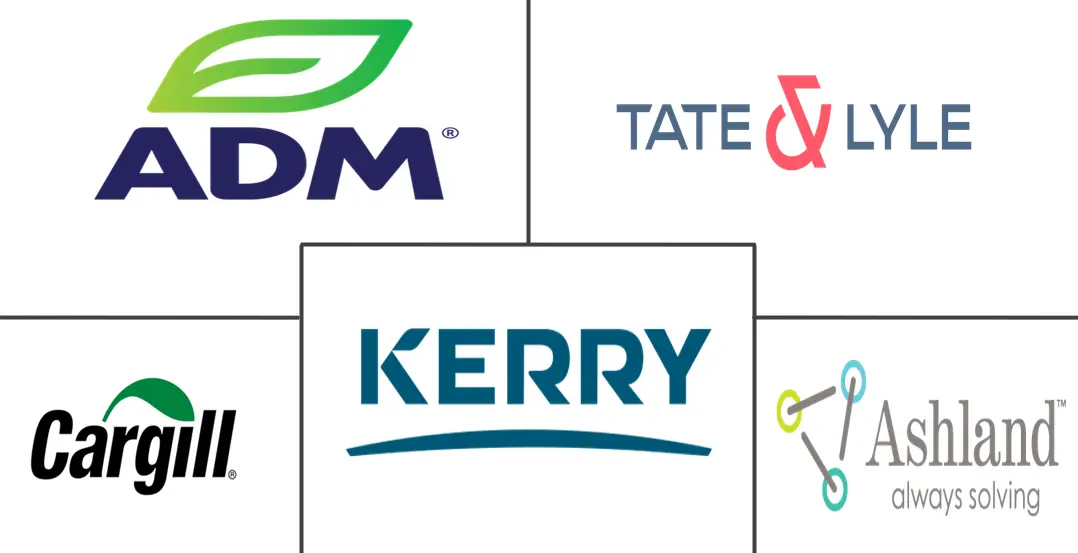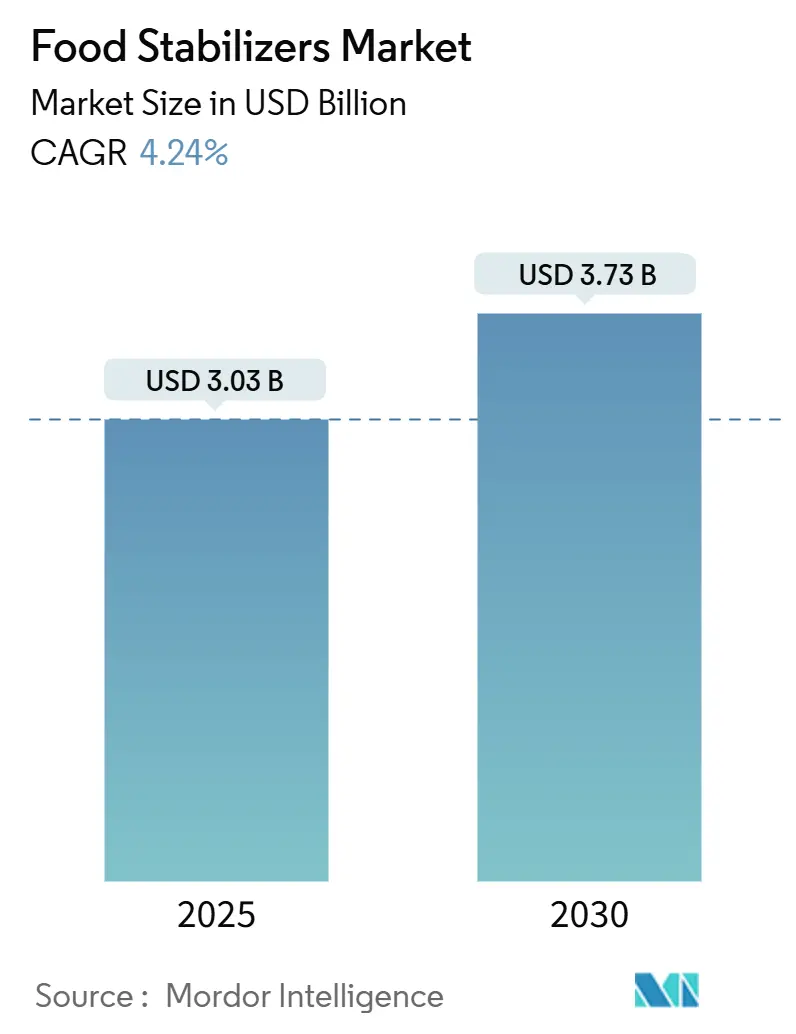
Food Stabilizers Market Analysis by Mordor Intelligence
The food stabilizers market size is valued at USD 3.03 billion in 2025 and is expected to reach USD 3.73 billion by 2030, growing at a CAGR of 4.24%. Food processors drive demand as they reformulate products to achieve clean-label status while maintaining texture, shelf stability, and cost efficiency. The industry is shifting toward natural hydrocolloids, fermented gums, and modified lecithins as alternatives to synthetic emulsifiers, supported by global regulatory approval of plant-based and microbial additives. Sustainability considerations influence purchasing decisions, with increased preference for stabilizers derived from certified seaweed, recycled citrus fiber, and fermentation byproducts. Companies that combine product effectiveness with supply chain transparency gain long-term contracts, reducing their vulnerability to raw material price volatility and regulatory changes.
Key Report Takeaways
- By source, plant-based solutions held 64.74% of food stabilizers market share in 2024, whereas microbial sources are projected to expand at a 5.54% CAGR from 2025-2030.
- By application, dairy and dairy alternatives led with 29.43% of the food stabilizers market size in 2024; jams and jellies are set to grow at a 6.04% CAGR to 2030.
- By geography, Europe dominated at 32.44% share in 2024, yet Asia-Pacific is forecast to post a 5.74% CAGR over 2025-2030.
Global Food Stabilizers Market Trends and Insights
Drivers Impact Analysis
| DRIVER | (~) % IMPACT ON CAGR FORECAST | GEOGRAPHIC RELEVANCE | IMPACT TIMELINE |
|---|---|---|---|
| Surging demand for processed and convenience food globally | +1.2% | Global, with the strongest impact in Asia-Pacific and Latin America | Medium term (2-4 years) |
| Consumer shift towards texture-enhanced clean label products | +0.9% | North America and Europe, expanding to Asia-Pacific urban centers | Long term (≥ 4 years) |
| Stabilizers extend product shelf life in food applications | +0.8% | Global, particularly relevant in emerging markets | Short term (≤ 2 years) |
| Emergence of stabilizer-infused functional confectionery | +0.6% | North America and Europe, premium segments in Asia-Pacific | Medium term (2-4 years) |
| Use of stabilizers in meat analogs to mimic animal protein texture | +0.5% | North America and Europe core, expanding to Asia-Pacific | Long term (≥ 4 years) |
| Demand for gluten-free, texturally rich foods driving natural stabilizer uptake | +0.4% | Global, with the highest penetration in North America and Europe | Medium term (2-4 years) |
| Source: Mordor Intelligence | |||
Surging demand for processed and convenience food globally
Urbanization and lifestyle changes are transforming food consumption patterns, driving increased processed food demand in emerging markets. This growth requires advanced stabilization technologies to maintain product quality throughout extended distribution chains and storage conditions. The rising preference for convenience foods increases the need for specialized stabilizers that withstand thermal processing while meeting clean-label requirements. The food industry continues to adapt to these evolving consumer preferences by developing innovative stabilization solutions. In Japan, the aging population is fueling demand for health-focused processed foods, with the USD 190 billion food processing industry emphasizing functional ingredients and shelf-stable products, according to the Ministry of Food Processing Industries' data [1]Ministry of Food Processing Industries, "Food and Beverages Food Trends", www.maff.co.jpfrom 2022. This demographic shift has prompted manufacturers to invest in research and development of stabilizers that can enhance nutritional value while extending product shelf life.
Consumer shift towards texture-enhanced clean label products
Growing health awareness among consumers is increasing the demand for transparency in food ingredients, including texture enhancers that can match the performance of synthetic additives. The focus has shifted beyond basic ingredient declarations to encompass natural texture enhancement solutions. This evolution reflects a broader industry movement toward clean-label formulations that meet consumer expectations. In 2024, Tate & Lyle introduced its formulation tool 'Tate & Lyle Sensation™' to address the market need for texture optimization while maintaining clean-label standards. Rice and tapioca maltodextrin have emerged as functional substitutes for conventional stabilizers, offering thickening and binding properties without chemical modifications. These natural alternatives demonstrate versatility across various food applications, from bakery products to beverages. However, manufacturers face the challenge of achieving cost-effectiveness comparable to synthetic alternatives while ensuring consistent performance.
Stabilizers extend product shelf life in food applications
The demand for food stabilizers is increasing due to their role in extending product shelf life and maintaining food quality across distribution chains, which helps reduce food waste. These ingredients provide economic benefits through waste reduction and supply chain optimization, especially in emerging markets with limited cold chain infrastructure. The strategic importance of stabilizers continues to grow as food manufacturers seek solutions to minimize waste throughout their operations. Their application helps ensure product consistency and quality from production through final consumption, making them essential in modern food processing. Alginates create films that effectively block moisture and gases, extending shelf life while remaining biodegradable. The development of precision fermentation enables the production of stabilizers that offer improved functionality and lower environmental impact, supporting both preservation and sustainability goals. These technological advancements have made stabilizers more efficient and environmentally friendly, meeting the increasing consumer demand for sustainable food products.
Emergence of stabilizer-infused functional confectionery
The confectionery sector is experiencing transformation through the integration of functional stabilizers that deliver health benefits beyond traditional texture enhancement. Pectin's recognition among consumers and its regulatory status as a safe food substance supported a 7% increase in new product launches containing pectin in Europe from 2022 to 2023, according to a Cargill report from 2023. Functional confectionery incorporating prebiotic fibers and stabilizers addresses consumer demand for indulgent products with health positioning. Hydrocolloids are proving essential in creating healthier confectionery products by reducing sugar and fat content while maintaining sensory qualities. The challenge lies in balancing functional benefits with taste expectations, requiring sophisticated stabilizer formulations that mask off-flavors while delivering desired textures.
Restraint Impact Analysis
| RESTRAINT | (~) % IMPACT ON CAGR FORECAST | GEOGRAPHIC RELEVANCE | IMPACT TIMELINE |
|---|---|---|---|
| Regulatory compliance requirements impact food additives market | -0.7% | Global, with the strictest impact in the Europe and California | Short term (≤ 2 years) |
| Consumer demand for minimal ingredients list hindering stabilizer usage | -0.5% | North America and Europe, spreading to APAC urban markets | Medium term (2-4 years) |
| Religious/ethical restrictions on animal-derived gelatin | -0.4% | Global, particularly Middle East and Northern Africa, South Asia, and Western markets | Long term (≥ 4 years) |
| Challenges in formulating with stabilizers in low-pH or high-salt products | -0.3% | Global, affecting specialty food applications | Short term (≤ 2 years) |
| Source: Mordor Intelligence | |||
Regulatory compliance requirements impact food additives market
Escalating regulatory scrutiny is creating compliance complexities that constrain market growth and increase development costs across global markets. California's Food Safety Act [2]California Legislative Information, “AB 418 Food Product Safety,” leginfo.legislature.ca.gov banning four toxic additives, including potassium bromate and propylparaben, took effect in January 2025, triggering similar legislation in New York and Illinois. The European Union's updated novel food application guidance, effective February 2025, introduces enhanced requirements for microorganism-related foods, comprehensive composition data, and expanded toxicological assessments. China's implementation of food additive standard GB2760-2024 in February 2025 creates additional compliance burdens for global suppliers seeking market access. The FDA's Human Foods Program prioritizes food chemical safety in FY 2025, focusing on enhanced regulatory oversight of additives and contaminants. These regulatory developments extend product development timelines and increase costs, particularly for smaller companies lacking regulatory expertise and resources.
Religious/ethical restrictions on animal-derived gelatin
Growing consumer awareness of ingredient origins and ethical considerations is constraining the use of animal-derived stabilizers, particularly gelatin, across multiple market segments. Halal, kosher, and vegan dietary restrictions affect significant population segments globally, with plant-based food trends accelerating beyond traditional vegetarian demographics. The shift toward plant-based alternatives is driving innovation in hydrocolloid technologies, with seaweed-derived options like carrageenan and alginate gaining preference despite higher costs. Consumer willingness to pay premiums for ethical ingredients is creating market segmentation, with premium products commanding higher margins while constraining volume growth in price-sensitive segments. The challenge extends beyond ingredient substitution to performance matching, as animal-derived gelatin offers unique gelling properties that plant-based alternatives struggle to replicate across all applications.
Segment Analysis
By Source: Microbial Technologies Challenge Plant Dominance
Plant-based sources command 64.74% market share in 2024, reflecting established supply chains and consumer preference for recognizable natural ingredients. However, microbial sources represent the fastest-growing segment at 5.54% CAGR through 2030, driven by precision fermentation advances and sustainability advantages. Seaweed-derived stabilizers maintain steady demand, while synthetic alternatives face increasing regulatory and consumer pressure. Animal-derived sources continue declining as ethical and religious considerations drive substitution.
The microbial segment's growth acceleration stems from technological breakthroughs in fermentation efficiency and cost reduction. Companies are investing in single-cell protein production and metabolic engineering to create stabilizers with enhanced functionality compared to plant-derived alternatives. Regulatory support for biotechnology-derived ingredients, including the FDA's GRAS notification process, facilitates market entry for innovative microbial stabilizers. The challenge lies in scaling production to achieve cost competitiveness with established plant-based alternatives while maintaining quality consistency.
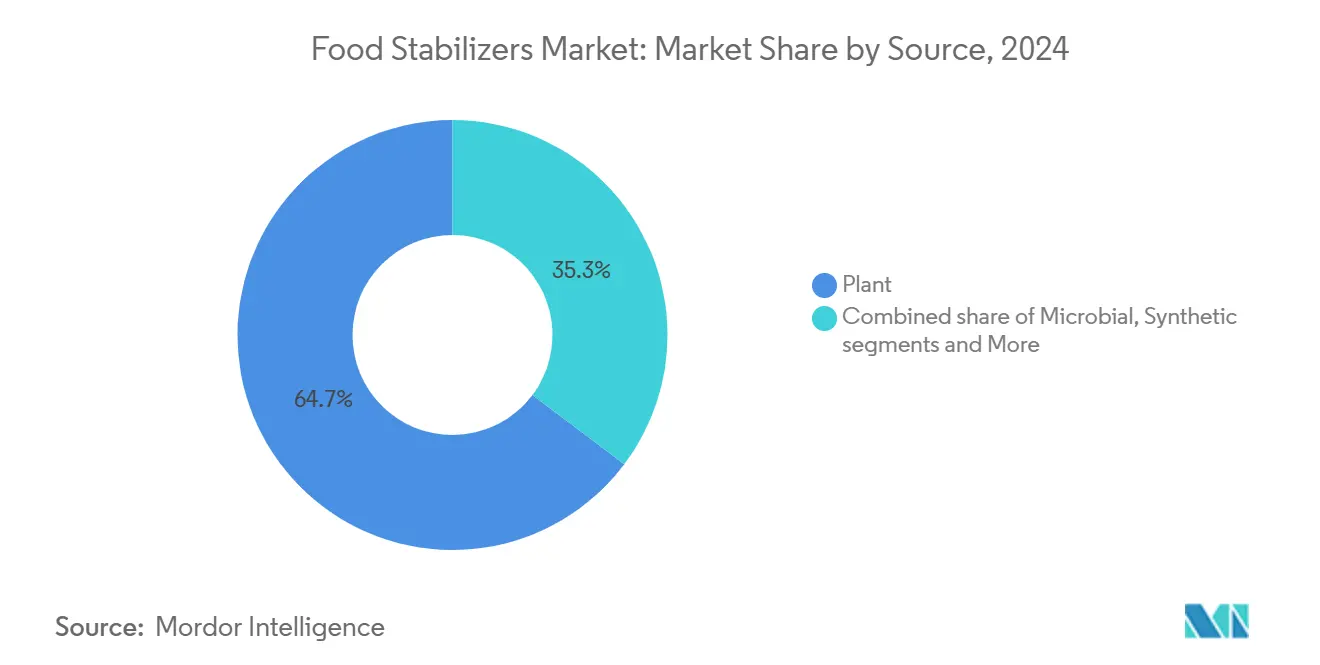
Note: Segment shares of all individual segments available upon report purchase
By Application: Jams and Jellies Lead Premium Segment Growth
Jams and jellies show the highest growth rate at 6.04% CAGR through 2030 in food stabilizer applications, driven by artisanal food production and premium positioning. Dairy and dairy alternatives maintain the largest market share at 29.43% in 2024. Meat and poultry applications expand through plant-based meat development, while beverage applications grow due to functional drink demand. Bakery and confectionery applications maintain steady growth through clean-label reformulations. Sauces and dressings show moderate growth due to increased ethnic cuisine demand and premium product development.
Consumer preference for artisanal products with natural stabilizers like pectin supports the jams and jellies segment growth. Pectin's effectiveness in sugar reduction applications meets health-conscious consumer demands while maintaining clean-label requirements. The dairy segment's dominant position stems from stabilizer developments in plant-based alternatives, particularly in texture enhancement. Silvateam's product range, including Aglufiber FAS for stabilization and Aglupectin variants for yogurts, demonstrates the segment's technical requirements. Pickering emulsions provide sustainable stabilization solutions and fat replacement options for health-focused products.
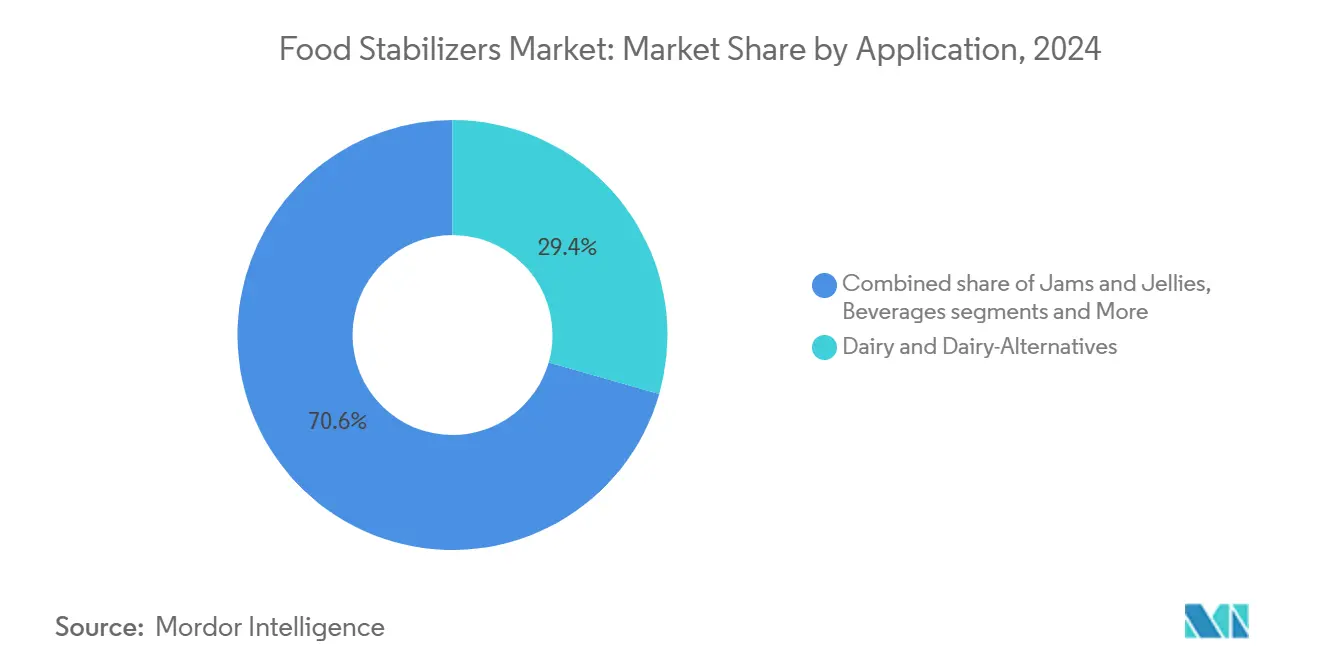
Note: Segment shares of all individual segments available upon report purchase
Geography Analysis
Europe holds a 32.44% market share in 2024, supported by comprehensive regulatory frameworks and consumer demand for natural ingredients. The European Food Safety Authority's rigorous evaluation processes for food additives establish significant market entry barriers while ensuring stability for approved ingredients. EFSA's [3]European Food Safety Authority, “Guidance on the Preparation and Presentation of Novel Food Applications,” efsa.europa.eu new guidance for novel food applications, starting February 2025, implements stricter requirements for microorganism-related foods and safety assessments. While this may extend approval timelines, it enhances consumer trust. The region's sustainability focus increases demand for biodegradable stabilizers and environmentally responsible packaging. European manufacturers are expanding seaweed cultivation and processing operations, with the seaweed hydrocolloids market growing at 5% annually due to health-conscious consumer preferences.
Asia-Pacific projects a 5.74% CAGR through 2030, driven by urbanization, middle-class expansion, and increased processed food consumption in developing economies. Japan's aging population creates demand for functional foods with longer shelf life, while India's food processing sector grows through government support and foreign investments.
North America shows consistent growth through clean-label trends and supportive regulations. The FDA's approval of 3 new natural color additives in 2025 demonstrates regulatory backing for clean-label innovation, while California's restrictions on synthetic additives prompt industry-wide product reformulation. South America and Middle East and Africa present growth potential, with Brazil's expanding food processing industry and the Middle East's increasing demand for halal-certified stabilizers driving regional development.
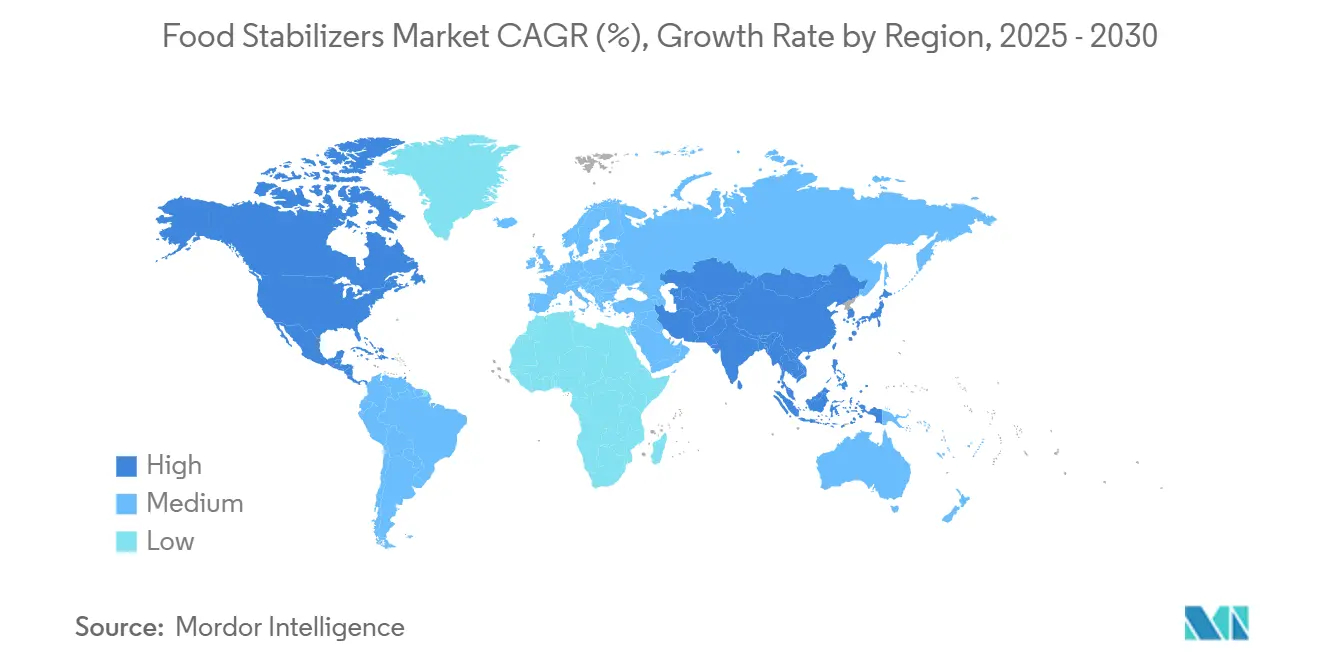
Competitive Landscape
The food stabilizers market exhibits moderate fragmentation, creating opportunities for both established multinational corporations and innovative biotechnology companies. Market leaders leverage vertical integration strategies, combining raw material sourcing with specialized processing capabilities to maintain cost competitiveness and quality consistency. Prominent market players include Cargill, Incorporated, Tate & Lyle Plc, Archer Daniels Midland Company, Kerry Group plc., and Ashland Co. Ltd.
The competitive dynamics increasingly favor companies investing in precision fermentation technologies and sustainable production methods, as regulatory pressures and consumer preferences shift toward natural alternatives. Strategic positioning emphasizes innovation in clean-label formulations and application-specific solutions rather than commodity-based competition.
White-space opportunities exist in specialized applications like plant-based meat analogs and functional confectionery, where texture matching remains technically challenging. Emerging disruptors focus on biotechnology platforms that can deliver novel stabilizers with enhanced functionality and reduced environmental impact compared to traditional alternatives.
Food Stabilizers Industry Leaders
-
Cargill, Incorporated
-
Tate & Lyle Plc
-
Archer Daniels Midland Company
-
Ashland Co. Ltd.
-
Kerry Group plc
- *Disclaimer: Major Players sorted in no particular order
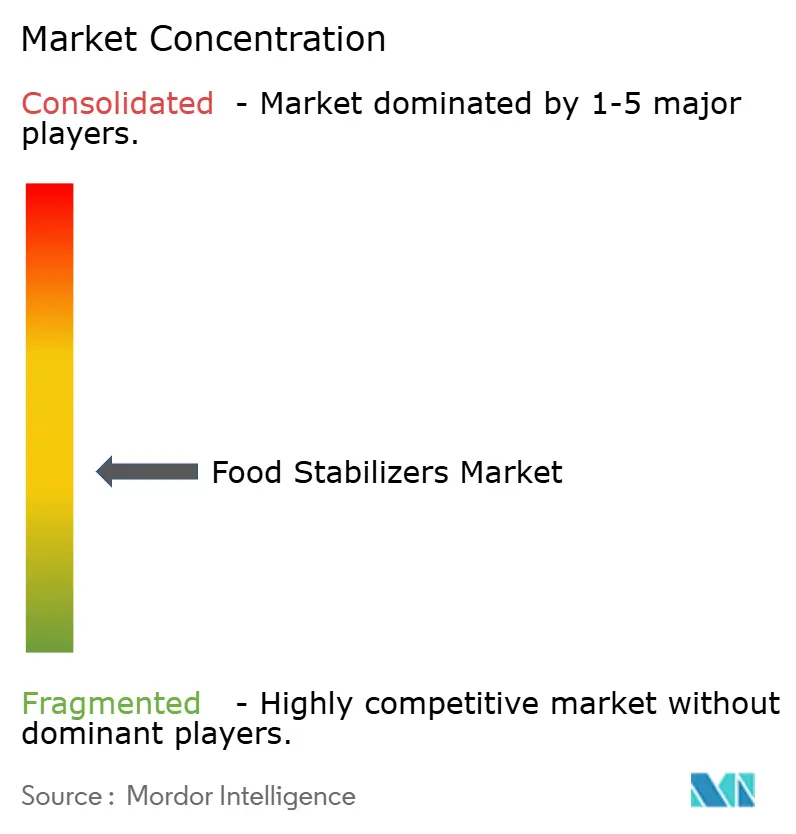


Recent Industry Developments
- June 2025: Ingredion, in a strategic maneuver, expanded its footprint in the Benelux region through a partnership with Univar Solutions. This collaboration not only bolsters Ingredion's distribution network across Europe but also aligns seamlessly with the burgeoning clean-label trend. The Benelux region, boasting a robust base of 16,000 food producers, presents a lucrative market for Ingredion's specialty ingredients, making this expansion a pivotal move in their market penetration strategy.
- May 2025: Austrade Inc. introduced a non-GMO hydrolyzed sunflower lecithin powder designed for functional beverage production. The manufacturing process involves enzymatic hydrolysis combined with concentration technology. The product is suitable for various applications, including plant-based coffee creamers, barista plant-based milks, nutritional beverages, protein-rich formulations, frozen desserts, and nutritional supplements.
- October 2024: Lesaffre, a key player in the food industry, took a significant step by acquiring a 70% stake in Biorigin. This move not only underscores Lesaffre's commitment to the market but also broadens its reach in yeast derivatives, catering specifically to savory foods and functional beverages.
- February 2024: Ingredion launched the first functional native, clean-label starch with gelling and improved mouthfeel capabilities. The new NOVATION Indulge 2940 functional native starch is a label-friendly ingredient that meets the demand of health-conscious consumers looking for an indulgent, plant-based texture in their foods.
Global Food Stabilizers Market Report Scope
A stabilizer is an additive to food that helps preserve its structure. The food stabilizer market is segmented by source, type, application, and geography. By source, the market is segmented into natural and synthetic. Natural stabilizer is further sub-segmented into plant, microbial, and animal-sourced food stabilizers. By type, the market is segmented into alginate, agar, gelatin, guar gum, cellulose and cellulose derivatives, and other types. By application, the market is segmented into bakery and confectionery, dairy, meat and poultry, beverages, sauces and dressings, and other applications. By geography, the market is segmented into North America, Europe, Asia-Pacific, South America, and Middle East and Africa. The market sizing has been done in value (USD) for all the abovementioned segments.
| Plant |
| Microbial |
| Seaweed |
| Synthetic |
| Animal |
| Bakery and Confectionary |
| Dairy and Dairy-alternatives |
| Meat and Poultry |
| Beverages |
| Sauces and Dressing |
| Jams and Jellies |
| Others |
| North America | United States |
| Canada | |
| Mexico | |
| Rest of North America | |
| Europe | United Kingdom |
| Germany | |
| Spain | |
| France | |
| Italy | |
| Russia | |
| Rest of Europe | |
| Asia-Pacific | China |
| India | |
| Japan | |
| Australia | |
| Rest of Asia-Pacific | |
| South America | Brazil |
| Argentina | |
| Rest of South America | |
| Middle East and Africa | Saudi Arabia |
| South Africa | |
| Rest of Middle East and Africa |
| By Source | Plant | |
| Microbial | ||
| Seaweed | ||
| Synthetic | ||
| Animal | ||
| By Application | Bakery and Confectionary | |
| Dairy and Dairy-alternatives | ||
| Meat and Poultry | ||
| Beverages | ||
| Sauces and Dressing | ||
| Jams and Jellies | ||
| Others | ||
| By Geography | North America | United States |
| Canada | ||
| Mexico | ||
| Rest of North America | ||
| Europe | United Kingdom | |
| Germany | ||
| Spain | ||
| France | ||
| Italy | ||
| Russia | ||
| Rest of Europe | ||
| Asia-Pacific | China | |
| India | ||
| Japan | ||
| Australia | ||
| Rest of Asia-Pacific | ||
| South America | Brazil | |
| Argentina | ||
| Rest of South America | ||
| Middle East and Africa | Saudi Arabia | |
| South Africa | ||
| Rest of Middle East and Africa | ||


Key Questions Answered in the Report
What is the current size of the food stabilizers market?
The market is valued at USD 3.03 billion in 2025 and is projected to reach USD 3.73 billion by 2030.
Which segment is growing fastest in the food stabilizers market?
Microbial-source stabilizers lead growth at a 5.54% CAGR through 2030, driven by precision fermentation advances.
Why are jams and jellies an attractive application area?
Artisanal positioning, sugar-reduction initiatives and pectin’s clean-label credentials support a 6.04% CAGR for stabilizers used in premium spreads.
Which region offers the greatest growth opportunity?
Asia-Pacific shows the highest expansion potential at a 5.74% CAGR thanks to rising processed-food consumption and supportive regulatory pathways.
Page last updated on:
